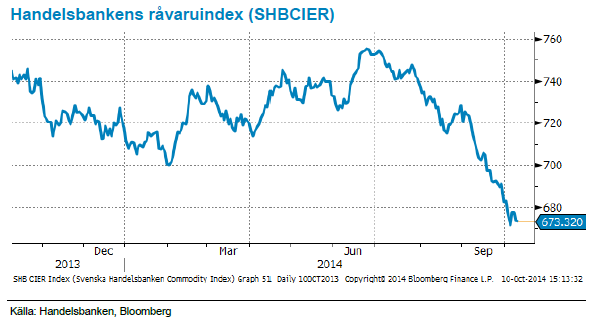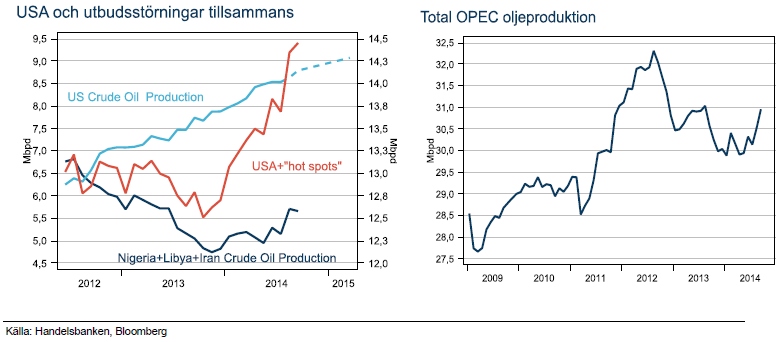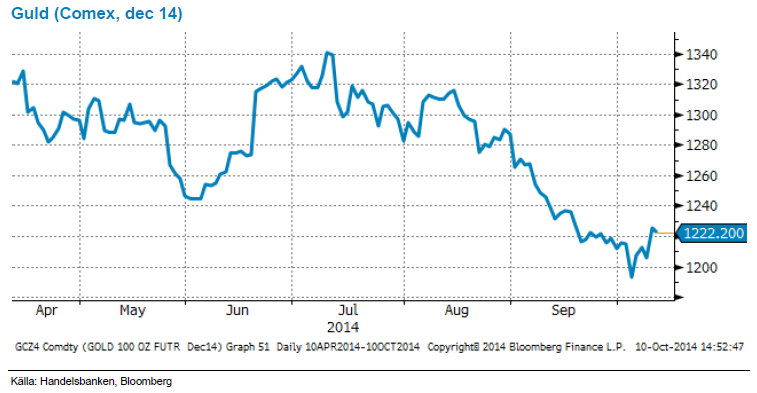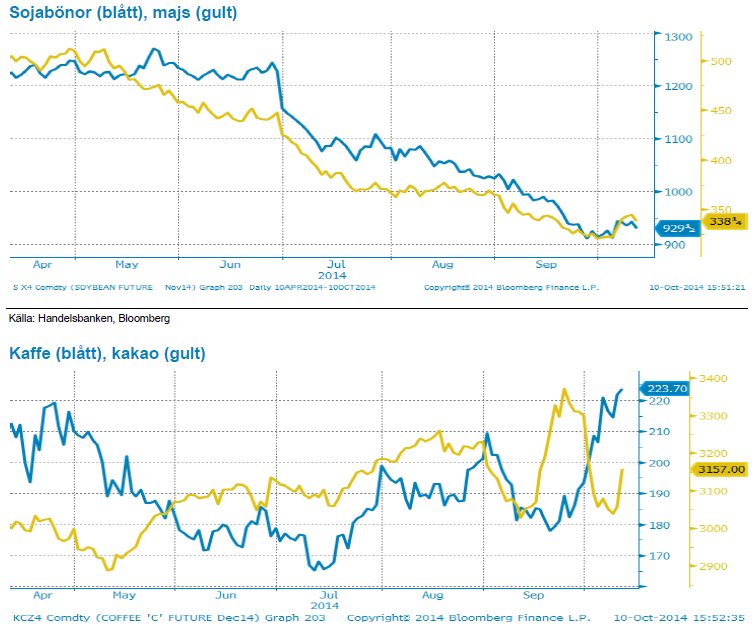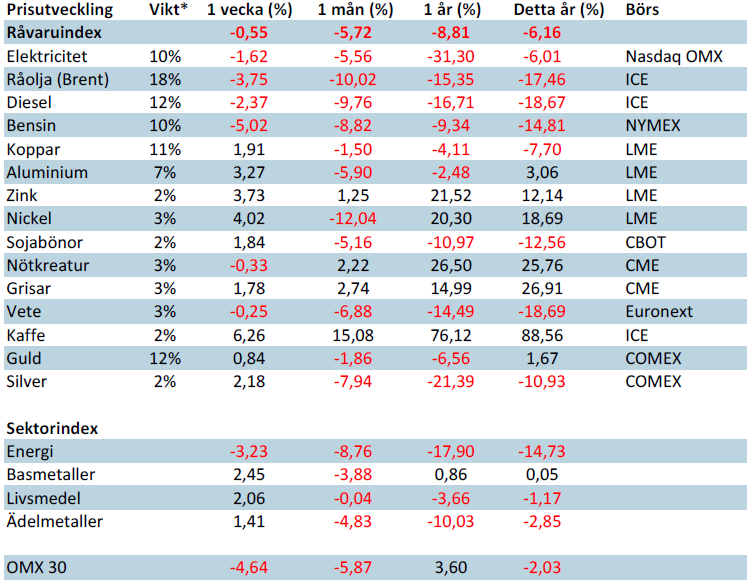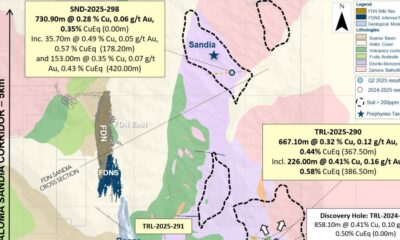Analys
SHB Råvarubrevet 10 oktober 2014

Råvaror allmänt: Händelserik vecka trots lite makrodata
Makro-agendan var tunn men blev trots det en besvikelse där Tyska tillverkningsorder och export varit överraskande svag i september. Europas viktigaste land följdes upp av ECB:s ledare Draghi som körde en upprepning av tidigare utsago och påtalade Europas strukturella problem snarare än konjunkturella. En ny besvikelse för marknaden och Europa är nu åter ett stort orosmoln. Draghi betonar att regeringar måste genomföra reformer. Regeringar med utrymme bör föra en mer expansiv finanspolitik
Från USA kom Fed protokollet (FOMC minutes) från mötet den 15-16 sep som visade ökad oro bland ledamöter för en starkare amerikansk dollar och global inbromsning med svaghet i europeisk ekonomi och inflation. Fed ledamöterna förordar räntor nära noll under en ”betydande tid” efter avslutade obligationsköp. Vissa förordar tålamod, snarare än motsatsen, i väntan på bevis om uthållig förbättring mot målet. Det var en Fed-röst som påtalade risker i globala tillväxten på ett sätt som marknaden inte förväntat sig.
Konjunkturhandlade råvaror, främst olja har varit svaga tillsammans med börsen på veckans utspel från centralbankerna.
Energi: Fokus på oljan
Oljan handlas nu under 90-strecket för första gången sedan juni 2012. Det året kunde man köpa olja för under 90 USD/fat dagen före midsommar i spåren av Libyens återkomst efter att Gaddafi hade störtats. Libyens oljeproduktion föll snart samman i efterföljande kamp om makten och priset steg tillbaka. Sedan 2011 har oljan rangehandlats till ett genomsnittspris på 110 USD/fat, medan WTI har handlats till rabatt p.g.a ökad inhemsk produktion och inlandshandelspunkt.
I år har oljan tappat 23 % från toppen i juni efter att USA:s oljeproduktion väntas nå 30 års högsta, att OPEC inte har skalat ned produktionen, att Rysslands oljeproduktion nära post-sovjet-all time high, att Saudi sänkte priset (istället för produktionen) på leveranser under november till Asien och att IMF sänkte prognosen för den globala tillväxten för 2015.
Varför har då inte oljan fallit tidigare om USA ökat produktionen sedan 2011? Det förklaras av att det under samma tid uppstått utbudsstörningar i en rad viktiga oljeländer som har inverkat negativt och kompenserat ut USA:s växande produktion. Effekten märktes inte i början av 2014 eftersom det fanns en rysslandsriskpremie i oljepriset men den har slagit igenom med full kraft efter den här sommaren. Se röd linje i graf nedan.
Marknadens oro har även ökat eftersom OPEC som brukligt inte aktivt bromsat fallet genom att strypa produktionen (se graf). Saudi minskade produktionen i augusti men data i september visade att OPEC ökat totala produktionen. Det betyder att övriga OPEC-länder inte följt Saudi. Flera medlemmar har varit överrens om förändring i produktion men endast Saudi har genomfört dem. Saudi vet att man i längden inte kan parera för USA:s årliga ökning utan man måste få med övriga kartellmedlemmar i båten.
Saudi svarade denna gång med att sänka priserna på november leveranser till Asien som är marginalköparen på den olja som USA inte längre importerar. Det ses som ett tecken på att OPEC håller på att destabiliseras och inte kan hantera USA:s växande produktion och minskade import. Nästa OPEC-möte är 27 november i Wien.
Ser vi till tillväxttakten i USA så har den toppat 2013, de enklaste brunnarna är borrade och halveringstakten är mycket hög vilket gör att det krävs allt mer investeringar för att fortsätta öka produktionen. Med senaste prognosen för 2015 som för första gången så kommer vi ner ordentligt i produktionstakt. Det vore ju därför märkligt om OPEC inte kan hantera situationen om nu USA effekten kommer minska inom 1 år.
Vi tror att den strukturella pressen kommer fortsätta, men på dessa nivåer kan den riskvillige köpa.
Ädelmetaller: Guldet studsar upp
Veckans FOMC minutes (Fed) gav guldpriset en ordentlig studs efter fallet på drygt 8 % under perioden juli till september. Protokollet tolkades som att Fed inte är alls så hökigt som tidigare befarat och fick dollarn på fall vilket gav ytterligare stöd till guldpriset.
Visst intresse för att köpa guld som säker hamn kan också skönjas efter senaste vågen av negativt sentiment kring Europa, tillspetsat av att IMF sänkte tillväxtprognosen för världen för 2015. Svagare börs hjälper också guld som alternativ investering. S&P är ner 4 % från toppen, fortsätter raset tror vi att det är läge att vara positiv till guldet.
Livsmedel: Kakao på 4 års-högsta
Under sista veckan i september nådde kakaopriset 4–årshögsta efter senaste tidens rapporter om den förvärrade situationen i Västafrika i samband med Ebolaspridningen och en eventuell spridning till Elfenbenskusten. Kakao handlas nu återigen på samma nivåer som innan uppgången, skördearbetet är i full gång med en förväntad rekordskörd från Elfenbenskusten.
Kaffe har skjutit i höjden på nytt och har i veckan handlats på årshögsta. En tidig utblomning orsakat av det ojämna klimatet i sydöstra Brasilien under året och regionen är i kraftigt behov av nederbörd. Läget är akut och markfuktigheten är långt under normalen i de viktiga odlingsområdena. Fortsätter det torra vädret finns det stor risk att torkan slår ut blommorna och skapar ännu större osäkerhet kring kommande års prognoser.
Priset på sojabönor har stigit under veckan, delvis som följd av skördefördröjande regn i USA och torrt väder i Brasilien. Än har inte regnet i USA gjort någon skada och torrare väder väntas inom de närmsta dagarna. Precis som för majsen fortsätter rapporter att visa på rekordavkastning efterhand som skörden fortskrider norrut och vi förväntar oss ytterligare uppjustering av den amerikanska sojans avkastning i kvällens USDA-rapport. Dryga 10 procent av den brasilianska sådden är avklarad utan större problem om än torrt i vissa regioner. Såvida inte torkan i Brasilien förvärras i större omfattning eller utsträckning tror vi att sojapriserna har ytterligare mer att falla. Påminner om det tradingcase på spreadcertifikat majs/sojabönor vi skickat ut tidigare. Läs mer här.
Handelsbankens råvaruindex (USD)
[box]SHB Råvarubrevet är producerat av Handelsbanken och publiceras i samarbete och med tillstånd på Råvarumarknaden.se[/box]
Ansvarsbegränsning
Detta material är producerat av Svenska Handelsbanken AB (publ) i fortsättningen kallad Handelsbanken. De som arbetar med innehållet är inte analytiker och materialet är inte oberoende investeringsanalys. Innehållet är uteslutande avsett för kunder i Sverige. Syftet är att ge en allmän information till Handelsbankens kunder och utgör inte ett personligt investeringsråd eller en personlig rekommendation. Informationen ska inte ensamt utgöra underlag för investeringsbeslut. Kunder bör inhämta råd från sina rådgivare och basera sina investeringsbeslut utifrån egen erfarenhet.
Informationen i materialet kan ändras och också avvika från de åsikter som uttrycks i oberoende investeringsanalyser från Handelsbanken. Informationen grundar sig på allmänt tillgänglig information och är hämtad från källor som bedöms som tillförlitliga, men riktigheten kan inte garanteras och informationen kan vara ofullständig eller nedkortad. Ingen del av förslaget får reproduceras eller distribueras till någon annan person utan att Handelsbanken dessförinnan lämnat sitt skriftliga medgivande. Handelsbanken ansvarar inte för att materialet används på ett sätt som strider mot förbudet mot vidarebefordran eller offentliggörs i strid med bankens regler.
Analys
OPEC+ in a process of retaking market share

Oil prices are likely to fall for a fourth straight year as OPEC+ unwinds cuts and retakes market share. We expect Brent crude to average USD 55/b in Q4/25 before OPEC+ steps in to stabilise the market into 2026. Surplus, stock building, oil prices are under pressure with OPEC+ calling the shots as to how rough it wants to play it. We see natural gas prices following parity with oil (except for seasonality) until LNG surplus arrives in late 2026/early 2027.

Oil market: Q4/25 and 2026 will be all about how OPEC+ chooses to play it
OPEC+ is in a process of unwinding voluntary cuts by a sub-group of the members and taking back market share. But the process looks set to be different from 2014-16, as the group doesn’t look likely to blindly lift production to take back market share. The group has stated very explicitly that it can just as well cut production as increase it ahead. While the oil price is unlikely to drop as violently and lasting as in 2014-16, it will likely fall further before the group steps in with fresh cuts to stabilise the price. We expect Brent to fall to USD 55/b in Q4/25 before the group steps in with fresh cuts at the end of the year.

Natural gas market: Winter risk ahead, yet LNG balance to loosen from 2026
The global gas market entered 2025 in a fragile state of balance. European reliance on LNG remains high, with Russian pipeline flows limited to Turkey and Russian LNG constrained by sanctions. Planned NCS maintenance in late summer could trim exports by up to 1.3 TWh/day, pressuring EU storage ahead of winter. Meanwhile, NE Asia accounts for more than 50% of global LNG demand, with China alone nearing a 20% share (~80 mt in 2024). US shale gas production has likely peaked after reaching 104.8 bcf/d, even as LNG export capacity expands rapidly, tightening the US balance. Global supply additions are limited until late 2026, when major US, Qatari and Canadian projects are due to start up. Until then, we expect TTF to average EUR 38/MWh through 2025, before easing as the new supply wave likely arrives in late 2026 and then in 2027.
Analys
Manufacturing PMIs ticking higher lends support to both copper and oil

Price action contained withing USD 2/b last week. Likely muted today as well with US closed. The Brent November contract is the new front-month contract as of today. It traded in a range of USD 66.37-68.49/b and closed the week up a mere 0.4% at USD 67.48/b. US oil inventory data didn’t make much of an impact on the Brent price last week as it is totally normal for US crude stocks to decline 2.4 mb/d this time of year as data showed. This morning Brent is up a meager 0.5% to USD 67.8/b. It is US Labor day today with US markets closed. Today’s price action is likely going to be muted due to that.

Improving manufacturing readings. China’s manufacturing PMI for August came in at 49.4 versus 49.3 for July. A marginal improvement. The total PMI index ticked up to 50.5 from 50.2 with non-manufacturing also helping it higher. The HCOB Eurozone manufacturing PMI was a disastrous 45.1 last December, but has since then been on a one-way street upwards to its current 50.5 for August. The S&P US manufacturing index jumped to 53.3 in August which was the highest since 2022 (US ISM manufacturing tomorrow). India manufacturing PMI rose further and to 59.3 for August which is the highest since at least 2022.
Are we in for global manufacturing expansion? Would help to explain copper at 10k and resilient oil. JPMorgan global manufacturing index for August is due tomorrow. It was 49.7 in July and has been below the 50-line since February. Looking at the above it looks like a good chance for moving into positive territory for global manufacturing. A copper price of USD 9935/ton, sniffing at the 10k line could be a reflection of that. An oil price holding up fairly well at close to USD 68/b despite the fact that oil balances for Q4-25 and 2026 looks bloated could be another reflection that global manufacturing may be accelerating.
US manufacturing PMI by S&P rose to 53.3 in August. It was published on 21 August, so not at all newly released. But the US ISM manufacturing PMI is due tomorrow and has the potential to follow suite with a strong manufacturing reading.
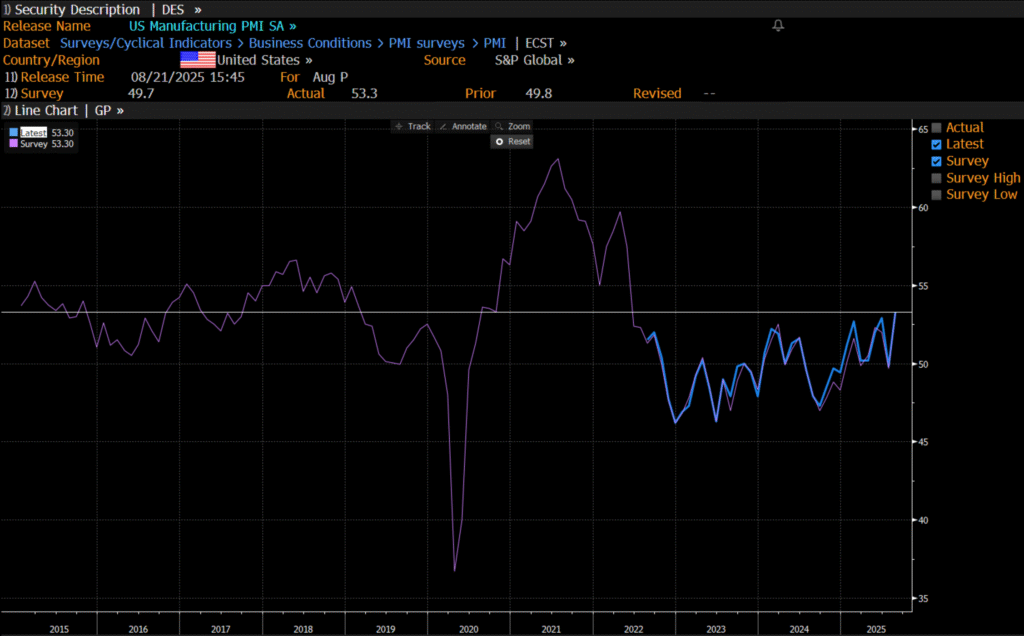
Analys
Crude stocks fall again – diesel tightness persists

U.S. commercial crude inventories posted another draw last week, falling by 2.4 million barrels to 418.3 million barrels, according to the latest DOE report. Inventories are now 6% below the five-year seasonal average, underlining a persistently tight supply picture as we move into the post-peak demand season.

While the draw was smaller than last week’s 6 million barrel decline, the trend remains consistent with seasonal patterns. Current inventories are still well below the 2015–2022 average of around 449 million barrels.
Gasoline inventories dropped by 1.2 million barrels and are now close to the five-year average. The breakdown showed a modest increase in finished gasoline offset by a decline in blending components – hinting at steady end-user demand.
Diesel inventories saw yet another sharp move, falling by 1.8 million barrels. Stocks are now 15% below the five-year average, pointing to sustained tightness in middle distillates. In fact, diesel remains the most undersupplied segment, with current inventory levels at the very low end of the historical range (see page 3 attached).
Total commercial petroleum inventories – including crude and products but excluding the SPR – fell by 4.4 million barrels on the week, bringing total inventories to approximately 1,259 million barrels. Despite rising refinery utilization at 94.6%, the broader inventory complex remains structurally tight.
On the demand side, the DOE’s ‘products supplied’ metric – a proxy for implied consumption – stayed strong. Total product demand averaged 21.2 million barrels per day over the last four weeks, up 2.5% YoY. Diesel and jet fuel were the standouts, up 7.7% and 1.7%, respectively, while gasoline demand softened slightly, down 1.1% YoY. The figures reflect a still-solid late-summer demand environment, particularly in industrial and freight-related sectors.

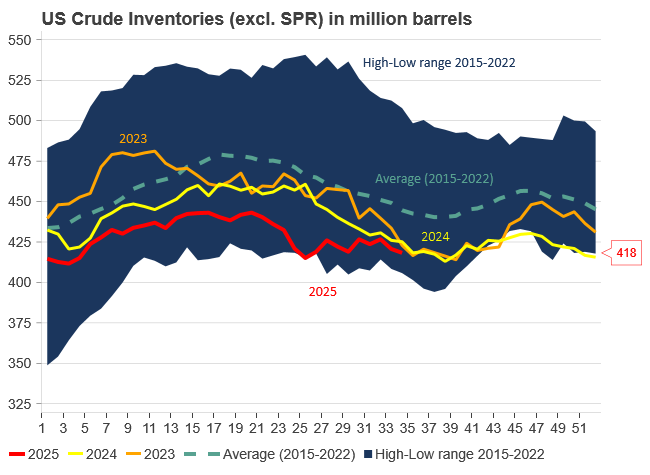
-
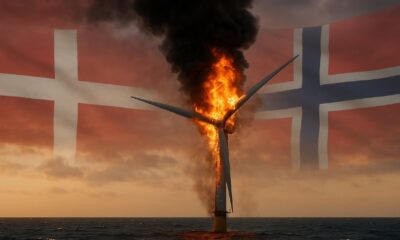
 Nyheter4 veckor sedan
Nyheter4 veckor sedanOmgående mångmiljardfiasko för Equinors satsning på Ørsted och vindkraft
-

 Nyheter2 veckor sedan
Nyheter2 veckor sedanMeta bygger ett AI-datacenter på 5 GW och 2,25 GW gaskraftverk
-

 Nyheter4 veckor sedan
Nyheter4 veckor sedanGuld stiger till över 3500 USD på osäkerhet i världen
-

 Analys4 veckor sedan
Analys4 veckor sedanWhat OPEC+ is doing, what it is saying and what we are hearing
-
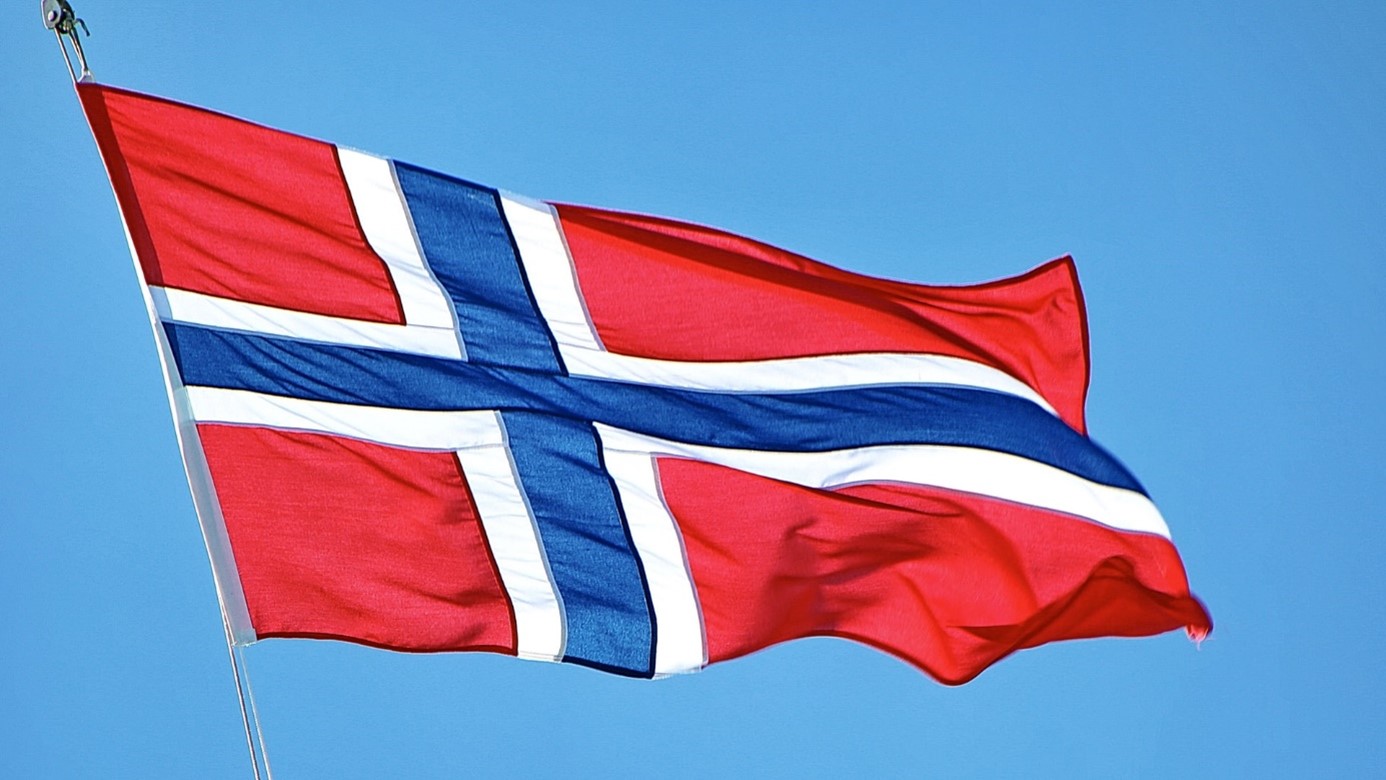
 Nyheter2 veckor sedan
Nyheter2 veckor sedanAker BP gör ett av Norges största oljefynd på ett decennium, stärker resurserna i Yggdrasilområdet
-

 Nyheter4 veckor sedan
Nyheter4 veckor sedanLyten, tillverkare av litium-svavelbatterier, tar över Northvolts tillgångar i Sverige och Tyskland
-

 Analys3 veckor sedan
Analys3 veckor sedanBrent sideways on sanctions and peace talks
-

 Nyheter3 veckor sedan
Nyheter3 veckor sedanEtt samtal om koppar, kaffe och spannmål


